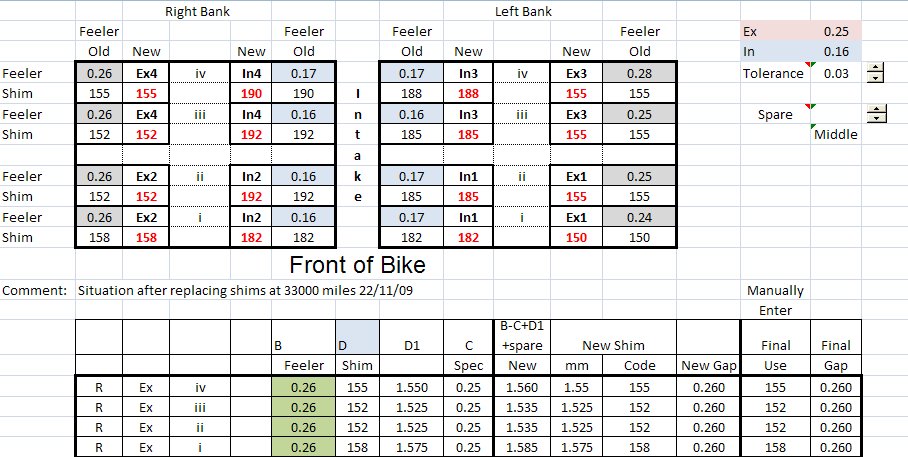

This is my own metric shim calculator. The above shows a small screen shot. The spreadsheet also works out what you have, what you need, and what you should buy. It gives you the opportunity to play with the tolerances, and whether to err on the slack side or the tight side.
Instructions:Fill in the tables at the top - enter the old feeler measurements in mm, and the shim number. The diagram shows the 8 valves on each side of the bike, looking from the front (so the left of the bike is on your right).
The calculations are caried out in the table underneath. Play with the tolerance 'spinner'. measurements out of the tolerance range show up green for over (too slack) , pink for under (too tight).
Play with the 'spare spinner'. This allows you to weight the tolerance up to +/- 0.03mm. So if you expect the shims to tighten, you may wish to err on the side of slack clearances.
The calculator looks up and calculates using actual shim thickness - ie 158 uses the actual thickness as being 1.575mm., 152 uses 1.525mm.
The final 2 columns are where you decide what shims you will actually use. Typically, these will be what is shown in the New Shim Code and New Shim Gap columns. But you carry out the check yourself, and enter the new shim number by hand. This is the final shim size that you intend to use, and no amount of playing with spinners will change what you have entered. The final gap is colour coded to indicate over and under tolerance.
The final shim code is copied to the cylinder diagram at the top of the sheet - (shown in red bold). This diagram therefore shows the old feeler gauge reading, the old shim and the new shim. It should be a useful final mental check when inserting the shims.
The table to the right (not shown above) uses how many of each shim size you have, and calculates how many of each shim size you need, and hence what you need to buy.
Below are the links to the Excel spreadsheets. Both versions are identical - you can use either for metric or imperial. The only difference is that the metric version comes with example metric data, the imperial version is populated with example imperial data. You may get an error message popping up behind your current window. (Shrink your windows if the spreadsheet doesn't open). This is because it is an xlsx file which I have named as an xls file.

These pages are merely a personal record of maintaining a
Honda ST1300.
Anyone carrying out similar work should acquaint themselves with the official,
correct procedures or employ the services of a qualified technician.